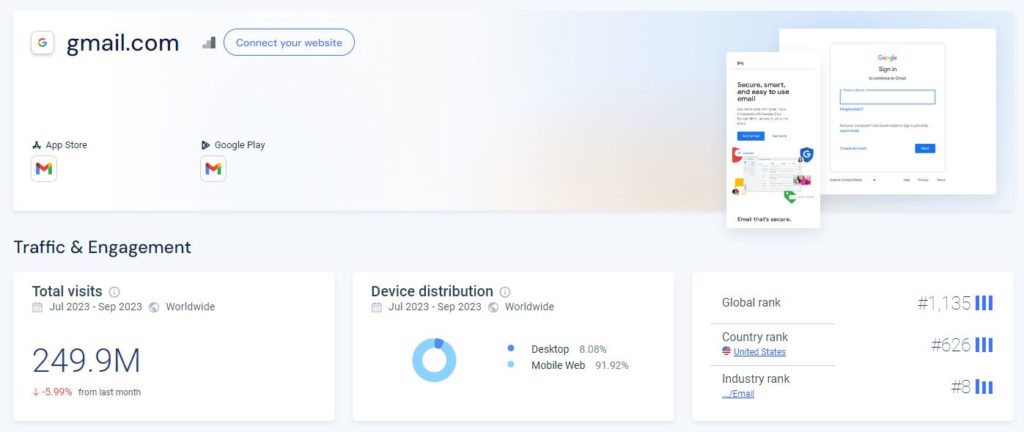
Is Gmail Good for SEO?
Gmail, launched by Google in 2004, quickly rose to prominence as one of the leading email services worldwide. It’s a powerful platform offering more than just email services: with a suite of connected features like Google Drive, Calendar, and more, it’s a hub for personal and professional communication. So the burning question is: Can an email service like Gmail, which is designed for private communication, contribute to your website’s SEO efforts?
| Website: | Gmail.com |
| Founded: | 2004 |
| Type of Platform: | Email Service |
| Key Features: | Email organization, spam filtering, search functionality, integration with other Google services |
| Content Types: | Emails, Attachments |
| Popular Content: | Emails, Attachments |
| Target Audience: | Individuals, businesses, organizations |
| Domain Authority: | 99/100 |
Most importantly, Gmail holds a high domain authority (DA). DA is a search engine ranking score developed by Moz that predicts how likely a website is to rank in search engine result pages (SERPs). Gmail’s DA is at the top of the scale, which in theory could pass on some credibility to linked content.

But here’s where it gets tricky: not all backlinks are created equal, and the platform they come from plays a significant role in the value they offer.
The answer isn’t straightforward. Gmail itself, being a private and secure platform, isn’t directly crawled by search engines like a public website would be. Therefore, the usual backlink strategies don’t apply here in the traditional sense. However, Gmail can be part of a broader SEO strategy in different and sometimes unexpected ways, which we’ll explore as we delve deeper into this topic.
Are Gmail Links Nofollow or Dofollow?
Since Gmail is a private, user-focused email platform and not a public content platform, the links within emails are inherently nofollow.
In the world of SEO, “Dofollow” and “Nofollow” are terms that signify how search engines should perceive links. Dofollow links are like open doors inviting search engines to consider the link as part of their ranking algorithms. They pass along what we call ‘link juice,’ potentially boosting the authority of the recipient site. Nofollow links, on the other hand, are a way to tell search engines to ignore a link in terms of passing on authority, as if saying, “Don’t count this one.”
When you share a link through a Gmail message, you’re essentially sharing it in a private context, not a public space that search engines are indexing. Therefore, even if Gmail has an impressive domain authority, the links shared in emails don’t pass SEO benefits directly from Gmail to your website. In summary, while Gmail might be a powerhouse for communication, when it comes to direct SEO benefits from backlinking, it’s not the platform you’d look to for dofollow links.
How Do I Add a Backlink to Gmail?
A backlink is essentially a link from one website to another. Think of it like a reference in a research paper; it leads readers from one piece of content to another, potentially offering additional context or information.
You can get a link from Gmail by emailing a lot of people with your link.
The Guide to Submitting a Backlink Using Gmail
While our backlink strategies don’t work directly with Gmail, there are ways to use Gmail to build links for your website:
Adding a hyperlink to an email message can help your website or business gain traffic. To embed a backlink within Gmail is straightforward. Here’s a step-by-step guide:
- Open Your Gmail Account: Log into your Gmail account. Hit ‘Compose’ to start a new email.
- Craft Your Email: Write your email content as you normally would. When you reach the point where you want to insert your backlink, continue to the next step.
- Highlight the Anchor Text: Select the text (this is called the “anchor text”) that you want to turn into a clickable backlink. This could be anything from ‘Click Here’ to a full URL.
- Insert the Link: With the text selected, look for the link icon in the formatting options at the bottom of the compose window (it looks like a chain link). Click on it.
- Enter Your URL: A small window will pop up asking for the web address (URL) you want to link to. Paste or type the URL into the field provided.
- Apply the Link: Hit ‘OK’, ‘Apply’, or simply press Enter. Your selected text will now be underlined and in a different color, indicating it is a hyperlink.
- Test the Link: It’s good practice to test the link. Click on the linked text while holding down the Ctrl key (Cmd on a Mac) to open the link in a new tab.
- Finish Your Email: Once the link is in place and tested, complete your email and hit ‘Send’.
The process is intuitive, even for those who aren’t particularly tech-savvy. Remember, while the link will be perfectly clickable and can direct people to your desired webpage, it carries no direct SEO weight due to Gmail’s nofollow nature. However, if your email recipients find the content valuable and choose to share it on platforms that do get indexed, this could indirectly benefit your SEO efforts.
Best Practices for Posting for Gmail
Crafting the perfect post on Gmail involves more than just writing an email and hitting send. It’s about ensuring your message is read, understood, and acted upon. Here’s how to nail it every time.
The Do’s and Don’ts of Crafting a Gmail
Do’s:
- Create a Domain Email Address: When sending links to others, it’s important that they take your email seriously. Emails like yourbusiness@gmail.com or yourname@gmail.com can be helpful, but an email like youname@yourbusiness.com adds much more authority to your message.
- Add a Profile Picture and Signature to your Gmail Account: Adding a professional signature and profile picture to your email account can also increase your trustworthiness among your audience.
- Make It Personal: Firstly, address your recipients by name. A personal touch goes a long way in showing you value the person on the other side of the screen.
- Subject Lines Matter: Craft a subject line that grabs attention but isn’t misleading. Think of it as the headline of an article; it should be compelling and relevant.
- Be Direct: If you’re asking for something, be upfront about it. Make your call-to-action (CTA) clear and impossible to miss.
- Test Links: Before sending, always check that any embedded links work. There’s little more frustrating than a call-to-action that leads nowhere.
Don’ts:
- Forget Privacy: Use BCC when sending to multiple recipients to keep email addresses private. Respecting the privacy of your email recipients can go a long way in building a relationship with them.
- Ignore Visuals: When appropriate, add images or logos to enhance your message. Visual aids can increase engagement and understanding.
- Forget About Mobile: Remember, a lot of email is read on mobile devices, so format your email to look good on small screens too.
- Spam: This should go without saying, but don’t bombard inboxes. Too many emails can lead to the ‘unsubscribe’ button.
By following these best practices, you’re not just sending an email; you’re delivering a message that stands out in a crowded inbox. While Gmail might not help with SEO directly, using it properly can make your business’s growth much easier.
Does AmpiFire Submit to Gmail?
When it comes to disseminating content across various platforms, AmpiFire, an automated content amplification engine, has been instrumental for many marketers and businesses. However, in the specific case of Gmail, the question arises: does AmpiFire submit to Gmail?
As of the latest updates, AmpiFire does not directly submit content to individual Gmail accounts. This is primarily due to the nature of Gmail as a personal and private email service, which is not a public platform for content distribution. AmpiFire’s expertise lies in amplifying content across channels that are public by nature, such as news sites, blogs, podcasts, social media, and video platforms.

While AmpiFire does not submit content to Gmail, it does provide users with powerful tools to create and distribute their message across multiple other high-traffic platforms, amplifying their reach while adhering to best online practices. Here’s how AmpiFire works:
- Content Creation: AmpiFire creates diverse content forms, including articles, blog posts, slide presentations, news stories, and audio advertisements. This content is tailored to promote a particular product, service, or website, and is designed to be engaging and informative.
- Omnipresence: The platform distributes this content across various channels and platforms on the web. This can range from social media networks to high-authority news sites, podcast directories, slide sharing sites, and more, with the aim of achieving a broad online presence for the content.
- Search Engine Optimization: As part of its service, AmpiFire ensures that the content is optimized for search engines. This means incorporating relevant keywords, meta tags, and descriptions to improve the visibility of the content on search engine results pages (SERPs), which can lead to increased traffic and backlink generation.
- Tracking and Reporting: AmpiFire provides analytics and reports on the performance of the distributed content. This includes tracking rankings, traffic, and engagement metrics, which can give users insights into the effectiveness of their content amplification campaign and ROI.
In conclusion, AmpiFire does not directly submit content to Gmail, as it is primarily an email platform and not a traditional channel for content distribution. However, the content amplification that AmpiFire provides could indirectly influence Gmail users if the distributed content reaches them through other integrated platforms or if it enhances overall online visibility. Ultimately, the goal of AmpiFire’s approach is to cast a wide net across various digital landscapes, potentially including the inboxes of engaged Gmail users.
Tired of not seeing the results your website deserves?
Discover AmpiFire and get your press releases be seen on Google News, YouTube, SlideShare, Apple Podcasts and many more…
Click Here To Learn More
Interested in maximizing your content’s reach? Discover how AmpiFire can amplify your digital presence far beyond the capabilities of a simple email. Does your content deserve a wider audience?
Frequently Asked Questions
Using Gmail alone isn’t a game-changer for SEO because direct links from emails don’t count as backlinks for search engine ranking. However, leveraging Gmail for networking and building relationships can indirectly boost SEO success.
Links shared through Gmail are inherently nofollow; they don’t pass on SEO benefits like dofollow links, which are gold mines for boosting your site’s authority.
The process to add a backlink in Gmail is straightforward: craft a compelling email, insert a hyperlink to your content, and make sure it provides value to the recipient, reinforcing the power of meaningful engagement over cold outreach.
While Gmail isn’t a posting platform, adhering to email etiquette—like personalizing your message, avoiding spammy behavior, and providing genuine value—can pave the way for robust engagement rates.
AmpiFire focuses its muscle on public platforms and doesn’t submit to Gmail, which is for personal communication, not public broadcasting. Comparatively, it’s like contrasting a billboard to a postcard—each serves a different purpose.
